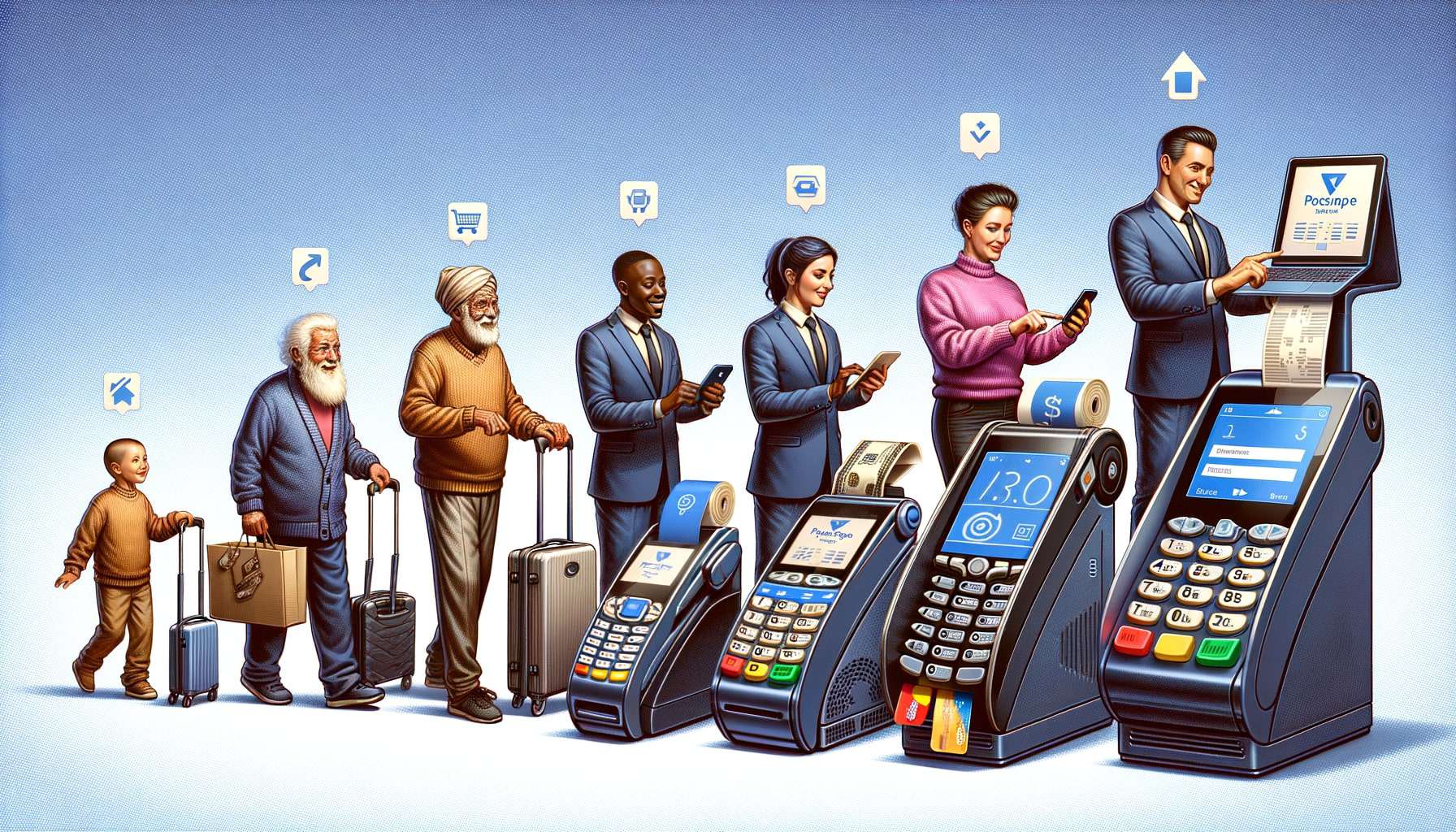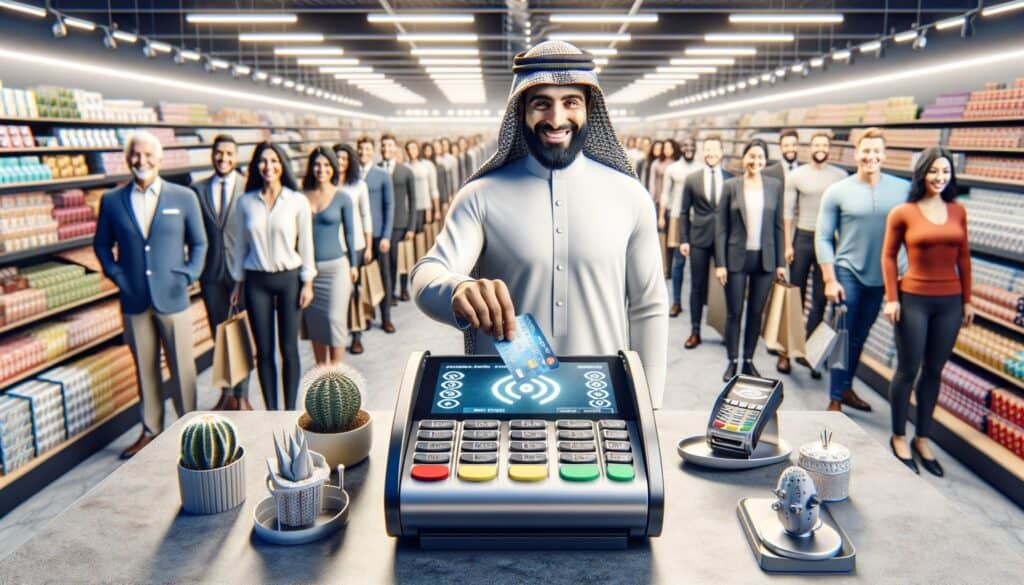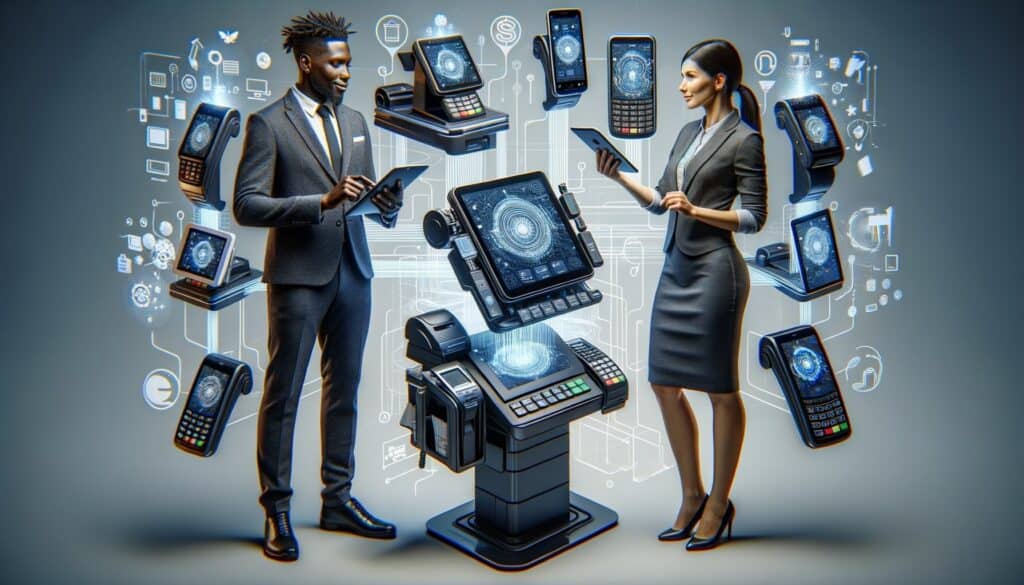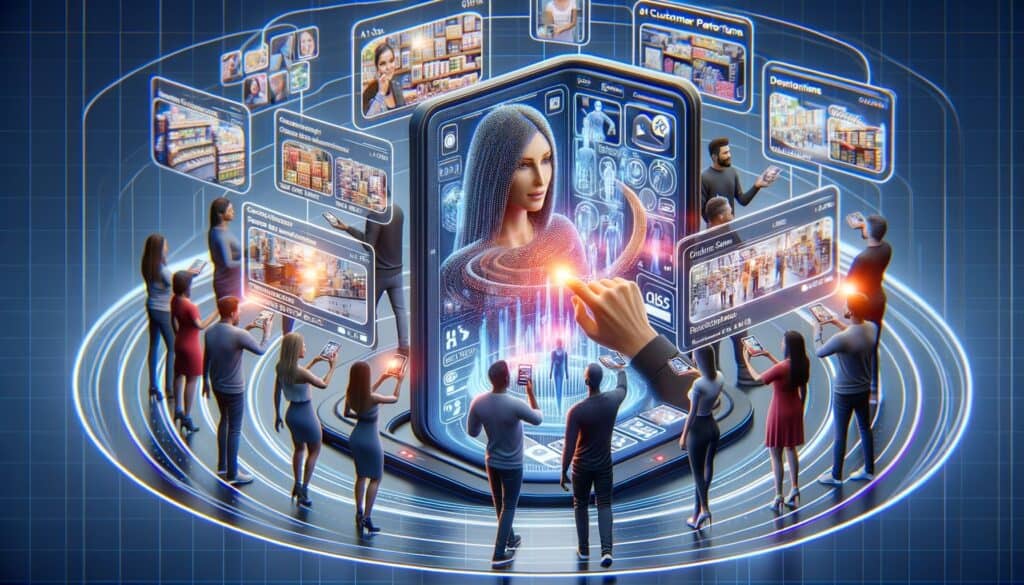
By Harriet Forster December 1, 2024
In today’s rapidly evolving retail landscape, consumer trends are constantly changing, driven by advancements in technology, shifting demographics, and evolving customer expectations. As a result, businesses need to adapt and embrace these trends to stay competitive and meet the demands of their customers. One area where this adaptation is particularly evident is in the evolution of point-of-sale (POS) systems.
POS systems have come a long way from their humble beginnings as cash registers. They have transformed into sophisticated tools that not only facilitate transactions but also play a crucial role in enhancing the overall customer experience. In this article, we will explore how point-of-sale (POS) systems are adapting to evolving consumer trends and the various ways they are revolutionizing the retail industry.
Understanding the Key Consumer Trends Shaping the Retail Landscape

To understand how POS systems are adapting, it is essential to first examine the key consumer trends that are shaping the retail landscape. One of the most significant trends is the growing demand for personalized experiences. Today’s consumers expect businesses to understand their individual preferences and provide tailored recommendations and offers. This trend has led to the rise of data-driven marketing strategies, and point-of-sale (POS) systems play a vital role in collecting and analyzing customer data to deliver personalized experiences.
Another trend that is reshaping the retail industry is the increasing popularity of mobile shopping. With the widespread adoption of smartphones, consumers now have the ability to shop anytime, anywhere. This has led to the integration of mobile technology into POS systems, allowing businesses to offer mobile payments, mobile loyalty programs, and mobile ordering options.
Additionally, the rise of omnichannel retailing has had a profound impact on consumer behavior. Consumers now expect a seamless shopping experience across multiple channels, whether it be in-store, online, or through social media. Point-of-sale (POS) systems have evolved to support omnichannel retailing by integrating inventory management, order fulfillment, and customer data across all channels.
The Role of Point of Sale (POS) systems in Enhancing Customer Experience

One of the primary ways POS systems are adapting to evolving consumer trends is by enhancing the overall customer experience. In today’s competitive retail landscape, providing exceptional customer service is crucial for building customer loyalty and driving repeat business. POS systems play a vital role in achieving this by streamlining the checkout process, reducing wait times, and offering convenient payment options.
Modern point-of-sale (POS) systems systems are equipped with features such as barcode scanners, touchscreen interfaces, and integrated payment processors, making the checkout process faster and more efficient. This not only improves customer satisfaction but also increases operational efficiency for businesses.
Furthermore, point-of-sale (POS) systems enable businesses to offer a variety of payment options, including contactless payments, mobile wallets, and online payments. This flexibility allows customers to choose the payment method that is most convenient for them, enhancing their overall shopping experience.
Harnessing the Power of Mobile Technology in POS Systems

Mobile technology has revolutionized the way consumers shop, and point-of-sale (POS) systems have adapted to leverage this trend. Mobile POS systems, also known as mPOS, have gained popularity in recent years, especially in industries such as hospitality and retail. These systems allow businesses to process transactions on mobile devices such as tablets or smartphones, eliminating the need for traditional cash registers.
mPOS systems offer several benefits for both businesses and customers. For businesses, they provide flexibility and mobility, allowing employees to assist customers anywhere in the store. This improves customer service and reduces wait times, leading to increased customer satisfaction.
For customers, mPOS systems offer convenience and speed. They can make purchases directly from a sales associate on the sales floor, eliminating the need to wait in line at a traditional checkout counter. This seamless and personalized shopping experience enhances customer satisfaction and encourages repeat business.
How POS Systems Cater to Individual Consumer Preferences

As mentioned earlier, personalization is a key consumer trend that businesses need to embrace. point-of-sale (POS) systems play a crucial role in collecting and analyzing customer data to understand individual preferences and deliver personalized experiences.
POS systems can capture a wealth of customer data, including purchase history, preferences, and demographics. This data can be used to create customer profiles and segment customers based on their preferences and behaviors. Businesses can then use this information to tailor marketing campaigns, offer personalized recommendations, and provide targeted promotions.
For example, a clothing retailer can use POS data to identify customers who frequently purchase a particular brand or style. They can then send personalized offers or recommendations to these customers, increasing the likelihood of a repeat purchase.
The Rise of Omnichannel Retailing and its Impact on POS Systems
Omnichannel retailing, which refers to the seamless integration of multiple sales channels, has become a necessity for businesses to stay competitive. Consumers now expect a consistent shopping experience across all channels, whether it be in-store, online, or through social media.
Point-of-Sale (POS) systems have evolved to support omnichannel retailing by integrating inventory management, order fulfillment, and customer data across all channels. This allows businesses to provide a unified shopping experience, regardless of the channel the customer chooses.
For example, if a customer purchases a product online and wants to return it in-store, a modern POS system can handle the return seamlessly. The system can access the customer’s purchase history, process the return, and update inventory levels in real-time. This integration ensures a smooth and consistent experience for the customer, regardless of the channel they choose to interact with the business.
Leveraging Data Analytics to Drive Business Growth and Consumer Insights
Data analytics has become an essential tool for businesses to gain insights into consumer behavior and drive business growth. Point-of-Sale (POS) systems play a crucial role in collecting and analyzing data that can be used to make informed business decisions and improve the overall customer experience.
POS systems can collect a wide range of data, including sales data, customer data, and inventory data. This data can be analyzed to identify trends, understand customer preferences, and optimize inventory management.
For example, by analyzing sales data, businesses can identify their top-selling products and adjust their inventory accordingly. They can also identify slow-moving products and take proactive measures to promote them or reduce inventory levels.
Furthermore, POS systems can provide real-time analytics and reporting, allowing businesses to monitor sales performance, track inventory levels, and identify areas for improvement. This data-driven approach enables businesses to make data-backed decisions and drive business growth.
Ensuring Data Security and Privacy in Modern POS Systems
With the increasing reliance on technology and the collection of customer data, data security and privacy have become major concerns for businesses and consumers alike. POS systems need to ensure the protection of sensitive customer information and comply with data protection regulations.
Modern POS systems employ various security measures to protect customer data. These measures include encryption of payment data, secure transmission of data, and compliance with industry standards such as the Payment Card Industry Data Security Standard (PCI DSS).
Additionally, businesses need to implement strict access controls and user authentication protocols to prevent unauthorized access to the POS system. Regular security audits and updates are also essential to address any vulnerabilities and ensure the system remains secure.
Integrating Emerging Technologies: AI, IoT, and Blockchain in POS Systems
As technology continues to advance, emerging technologies such as artificial intelligence (AI), the Internet of Things (IoT), and blockchain are being integrated into POS systems to enhance functionality and provide new capabilities.
AI can improve the functionality of POS systems by automating tasks, providing personalized recommendations, and enabling predictive analytics. For example, AI-powered chatbots can assist customers with their inquiries and provide personalized recommendations based on their preferences.
The IoT allows for the integration of various devices and sensors into POS systems, enabling businesses to gather real-time data and automate processes. For example, IoT-enabled sensors can monitor inventory levels and automatically trigger reordering when stock levels are low.
Blockchain technology has the potential to revolutionize the retail industry by providing secure and transparent transactions. It can be used to create a decentralized and tamper-proof record of transactions, ensuring data integrity and reducing the risk of fraud.
The Future of POS Systems: Anticipating and Adapting to Consumer Trends
As consumer trends continue to evolve, POS systems will need to adapt to meet the changing demands of customers. The future of POS systems lies in their ability to anticipate and adapt to these trends, providing businesses with the tools they need to stay competitive.
One of the key trends that POS systems will need to address is the increasing demand for contactless payments. With the ongoing COVID-19 pandemic, consumers are increasingly opting for contactless payment methods to minimize physical contact. POS systems will need to support a wide range of contactless payment options, including mobile wallets and QR code payments.
Another trend that POS systems will need to adapt to is the growing importance of sustainability and ethical consumption. Consumers are becoming more conscious of the environmental and social impact of their purchases. POS systems can play a role in supporting sustainable practices by providing information about product origins, certifications, and ethical sourcing.
Furthermore, as technology continues to advance, POS systems will need to embrace emerging technologies such as augmented reality (AR) and virtual reality (VR) to provide immersive shopping experiences. These technologies can allow customers to visualize products in their own space or try on virtual clothing, enhancing the online shopping experience.
FAQs
Q1. What are the main benefits of using a POS system in retail?
Using a POS system in retail offers several benefits, including streamlined checkout processes, improved inventory management, accurate sales reporting, and enhanced customer service. POS systems also enable businesses to collect and analyze customer data, leading to personalized experiences and targeted marketing campaigns.
Q2. How do POS systems enhance the customer experience?
POS systems enhance the customer experience by streamlining the checkout process, reducing wait times, and offering convenient payment options. They also enable businesses to provide personalized recommendations, targeted promotions, and seamless omnichannel experiences.
Q3. Can POS systems be customized to fit specific business needs?
Yes, POS systems can be customized to fit specific business needs. Businesses can choose from a range of features and functionalities to tailor the system to their requirements. Additionally, many POS systems offer integrations with other software and hardware, allowing businesses to create a customized solution.
Q4. What is the role of mobile technology in modern POS systems?
Mobile technology plays a significant role in modern POS systems. It enables businesses to offer mobile payments, mobile loyalty programs, and mobile ordering options. Mobile POS systems also provide flexibility and mobility, allowing employees to assist customers anywhere in the store.
Q5. How do POS systems support omnichannel retailing?
POS systems support omnichannel retailing by integrating inventory management, order fulfillment, and customer data across all channels. This integration ensures a seamless shopping experience for customers, regardless of the channel they choose to interact with the business.
Q6. What types of data can be collected and analyzed by POS systems?
POS systems can collect and analyze various types of data, including sales data, customer data, and inventory data. This data can be used to identify trends, understand customer preferences, and optimize inventory management.
Q7. How do POS systems ensure data security and privacy?
POS systems ensure data security and privacy through measures such as encryption of payment data, secure transmission of data, and compliance with industry standards. Strict access controls, user authentication protocols, and regular security audits are also essential to protect customer data.
Q8. What emerging technologies are being integrated into POS systems?
Emerging technologies such as AI, IoT, and blockchain are being integrated into POS systems. AI improves functionality by automating tasks and providing personalized recommendations. IoT enables the integration of devices and sensors for real-time data collection and automation. Blockchain provides secure and transparent transactions, ensuring data integrity.
Q9. How can AI improve the functionality of POS systems?
AI can improve the functionality of POS systems by automating tasks, providing personalized recommendations, and enabling predictive analytics. AI-powered chatbots, for example, can assist customers with inquiries and offer personalized recommendations based on their preferences.
Q10. What does the future hold for POS systems and their adaptation to consumer trends?
The future of POS systems lies in their ability to anticipate and adapt to consumer trends. This includes supporting contactless payments, embracing sustainability and ethical consumption, and integrating emerging technologies such as AR and VR to provide immersive shopping experiences.
Conclusion
POS systems have evolved significantly in response to changing consumer trends. They have transformed from simple cash registers to sophisticated tools that enhance the overall customer experience, cater to individual preferences, and support omnichannel retailing. POS systems leverage mobile technology, data analytics, and emerging technologies such as AI, IoT, and blockchain to provide businesses with the tools they need to stay competitive in today’s retail landscape.
As consumer trends continue to evolve, POS systems will need to adapt and embrace emerging technologies to meet the changing demands of customers. The future of POS systems lies in their ability to anticipate and adapt to these trends, providing businesses with the tools they need to deliver exceptional customer experiences and drive business growth. By staying ahead of the curve and embracing innovation, businesses can leverage POS systems to thrive in the ever-changing retail industry.